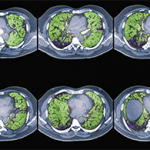Rheumatology fellows, Dr. Fischer says, need pulmonary training just as pulmonary fellows should have rheumatology training. “It starts with how we speak to our fellows, with how we speak to our colleagues, with how we train them,” he says. “Patients shouldn’t be finding out 20 years into having RA that it can affect the lungs. The lungs are involved in about one-third to half of RA patients and many patients have no idea.”
Although some rheumatologists or select centers have begun screening for lung disease in CTD patients, the level of expertise in this area is varied and rheumatologists lack clear guidelines for such assessments. In Dr. Fischer’s opinion, any RA patient who hasn’t been assessed for lung involvement as part of their evaluation should ask their rheumatologist to consider such testing.
“It’s part of the disease. The eyes are affected in a subset of patients. It’s not an arthritic condition in isolation. It’s a systemic autoimmune disease,” he says, adding that in other complex autoimmune diseases, such as lupus, the lungs are among favorite targets of the disease.
Challenges to Diagnosis
Although a multidisciplinary approach to diagnosing and treating these diseases is ideal, practical limitations remain and, often, effective collaboration between the two specialties is lacking.
Current approaches to screening CTD patients for ILD, or those who are at the highest risk for developing it, are insufficient, according to the report. The ideal approaches require identifying ILD in its earliest stages in combination with identifying patients who are at the greatest risk for disease progression and a decline of function.
Currently, diagnosing patients with CTD-associated ILD includes integration of the physical examination, history, testing of pulmonary function, lung imaging and histopathology studies. No validated biomarkers for the disease exist, which are important due to the heterogeneity of ILD. The report says biomarkers can become important tools in clinical practice, but specific measures should be accurate, accessible and reproducible.
Other unmet needs include accurate diagnostic imaging, an integration of histopathology, clinical trials and better treatment options. Example: No risk/benefit analysis has been conducted for the invasive procedure of undergoing a lung biopsy in these patients. However, CTD patients’ lung biopsies often reveal features of an autoimmune disease. These histopathologies are the gold standard in identifying fibrosis, and they may assist with determining a prognosis.
Although broad immunosuppression is the standard of care and sometimes modestly effective, there are currently no approved treatments for patients with CTD-associated ILD, highlighting the substantial need for large clinical trials, despite the significant challenges they may pose.

